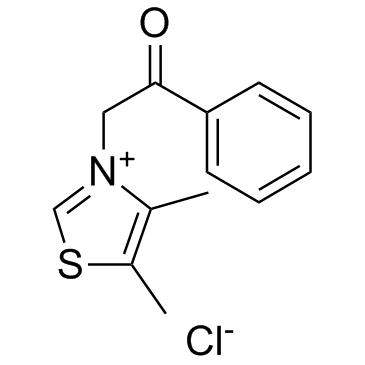Alagebrium chloride
Modify Date: 2024-01-10 12:12:17

Alagebrium chloride structure
|
Common Name | Alagebrium chloride | ||
|---|---|---|---|---|
| CAS Number | 341028-37-3 | Molecular Weight | 267.77400 | |
| Density | N/A | Boiling Point | N/A | |
| Molecular Formula | C13H14ClNOS | Melting Point | N/A | |
| MSDS | N/A | Flash Point | N/A | |
Use of Alagebrium chlorideAlagebrium chloride is an advanced glycation end product (AGE) inhibitor. |
| Name | 2-(4,5-dimethyl-1,3-thiazol-3-ium-3-yl)-1-phenylethanone,chloride |
|---|---|
| Synonym | More Synonyms |
| Description | Alagebrium chloride is an advanced glycation end product (AGE) inhibitor. |
|---|---|
| Related Catalog | |
| Target |
AGE[1] |
| In Vitro | Alagebrium chloride is an advanced glycation end product (AGE) inhibitor. Endothelial cell (EC) proliferation is increased for all groups receiving Alagebrium (ALT-711), particularly when seeded on matrix from the AAo of obese (ZO) and diabetic (ZD) rats[2]. |
| In Vivo | Blood pressure is not affected by treatment with Alagebrium. In diabetic RAGE apoE double-KO mice, treatment with Alagebrium is associated with a modest reduction in renal mass and reduces hyperfiltration compare with nontreated mice. Treatment with Alagebrium in diabetic RAGE apoE double-KO mice is associated with a further reduction in glomerular collagen IV levels, approaching levels observed in control mice[1]. Body weight, heart rate (HR), and mean blood pressure (BP) are similar in Zucker lean (ZL), obese (ZO), and diabetic (ZD) groups in the absence or presence of Alagebrium (ALT-711). Alagebrium increases blood flow (BF) in ZO rats but reduces distal vascular resistance in ZD rats. A decrease in neointimal hyperplasia (NH) intrastrut thickness as a function of local radius is found in all groups with Alagebrium treatment. A significant increase in TGF-β expression is also found in the AAo of ZL rats treated with Alagebrium[2]. |
| Cell Assay | Human aortic endothelial cells (HAECs) are seeded on decellularized matrices derived from the abdominal aorta (AAo) of Zucker lean (ZL), obese (ZO), and diabetic (ZD) rats with or without Alagebrium (ALT-711) (20 μg/mL in Dulbecco's PBS with 1× antibiotic-antimycotic). Experiments are performed when cells reach 80 to 90% confluence. Flow chambers are sealed to the HAEC monolayers via a vacuum network. Flow is driven by a Masterflex L/S peristaltic pump in a humidified chamber heated to 37°C for 4 h. Leibovitz-15 medium, supplemented with 10% FBS, endothelial BulletKit, and 1× antibiotic-antimycotic solution, is used as the flow medium to maintain pH in the absence of CO2[2]. |
| Animal Admin | RAGE apoE mice are randomized to be treated with Alagebrium (1 mg/kg/day by gavage), or no treatment (n=20/group). After 20 weeks of diabetes, mice are placed into individual metabolic cages for 24 h and urine is collected. Body weight as well as fluid and food intake are recorded. Urinary albumin excretion is estimated in urine samples by a mouse albumin enzyme-linked immunosorbent assay (ELISA) kit according to the kit protocol. Urinary and serum creatinine concentrations are measured by high-performance liquid chromatography (HPLC). Systolic blood pressure is assessed by a noninvasive tail cuff method in conscious mice at the end of the study[1]. |
| References |
| Molecular Formula | C13H14ClNOS |
|---|---|
| Molecular Weight | 267.77400 |
| Exact Mass | 267.04800 |
| PSA | 49.19000 |
| Hazard Codes | Xi |
|---|---|
| HS Code | 2934100090 |
| HS Code | 2934100090 |
|---|---|
| Summary | 2934100090 other compounds containing an unfused thiazole ring (whether or not hydrogenated) in the structure VAT:17.0% Tax rebate rate:9.0% Supervision conditions:none MFN tariff:6.5% General tariff:20.0% |
| Alagebrium chloride (USAN) |
| UNII-79QS8K2877 |
| Alagebrium chloride |
| ALT-711 |
| 4,5-Dimethyl-3-(2-oxo-2-phenylethyl)thiazol-3-ium chloride |
| 2-(4,5-dimethyl-1,3-thiazol-3-yl)-1-phenyl-ethanone chloride |

